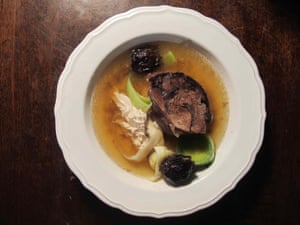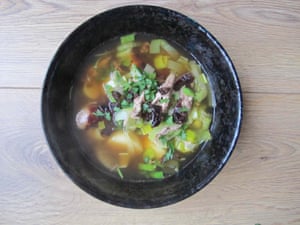St Andrew’s Day, which falls at the end of this month, is celebrated as the feast day of Scotland’s patron saint and a last hurrah before we disappear under an avalanche of mince pies and mulled wine. And if there’s one thing the Scots are good at, apart from politics, economics, terriers and whisky, it’s an honest broth. According to the Victorian journalist and author Christian Isobel Johnstone, who published her The Cook and Housewife’s Manual under the pseudonym Margaret Dods: “The French take the lead of all European people in soups and broths … the Scotch rank second, the Welsh next, and … the English, as a nation, are at the very bottom of the scale.” As an Edinburgh native, she may have been biased, but when one considers the likes of cullen skink, Scotch broth and our subject here, cock-a-leekie, it’s hard not to concede the point.
The last, occasionally known as cockie-leekie, is often dated to the end of the 16th century, when the Lincolnshire-born traveller Fynes Moryson records having been served “pullet with some prunes in the broth” at a knight’s house in Scotland, although, given the widespread medieval tradition of meat and fruit pottages, it seems likely that similar dishes were once found throughout northern Europe – even (horror!) south of the border. Happily for us, however, this particular version remained popular in Scotland, and feels a pleasingly simple and wholesome celebratory dish to prepare the stomach for the month to come.
The chicken
As ever, many recipes call for what the redoubtable Maw Broon calls “an auld boiling fowl” (thanks to Twitter friend of the column Jon Dryden Taylor forsupplying the recipe), which is, as we have seen previously, an appropriately tough thing to get hold of in 21st-century Britain. Catherine Brown reckons that “attempting a modern cock-a-leekie with an immature battery chicken is akin to attempting cassoulet without confit”, and, in the absence of decent chicken recommends using “a more flavourful pheasant or other game bird – cock or hen – which has roamed freely”. Having tried her recipe, I can confirm that pheasant makes a delicious soup, even when enjoyed from a bowl in a warm kitchen, rather than from a Thermos in the middle of a damp autumnal copse, but one with a distinct gamey character. Feel free to use pheasant here, if that’s what you have, but chicken, to some extent the older the better, remains the classic choice.
Clearly, I wouldn’t dream of using anything other than a free-range, if presumably still hopelessly immature, chicken for any of the recipes I test, but the difference between the others lies largely in the cut and the preparation. Jane Grigson andTom Kitchin call for whole birds, and Xanthe Clay and Graeme Taylor opt for chicken legs or drumsticks, with the latter roasting them before use.
At this point, the prospective cock-a-leekie cook is faced with a choice: one dish or two? Using a whole bird produces so much excess meat that there is enough left over for another meal entirely – coronation chicken or curry or pie, perhaps, as takes your fancy. As I am only dealing with the soup, however, I’m going to go for legs alone, which should at least have done a bit of work on a free-range bird, and are considerably cheaper by weight than a whole chicken, which might even mean you can afford to buy better.
Although roasting the meat first, as Taylor and Brown suggest, gives the broth the deep savouriness of a Sunday roast, if you have time to simmer the raw joints for several hours, you’ll reap a cleaner, clearer broth that testers claim tastes more intensely of chicken, and softer, juicier meat. (The time-pressed, however, should follow Taylor’s lead to have cock-a-leekie on the table in under two hours.)
Many older recipes, including Johnstone’s and that in F Marian McNeill’s 1929 work The Scots Kitchen: Its Traditions and Lore with Old-time Recipes, also include beef of some sort, Johnstone being of the belief that, “if soup be the foundation of a good dinner, it is equally true that beef is the only foundation of a good soup.” Grigson’s version, from the Observer Guide to British Cookery, also collected in the Best of Jane Grigson, makes a stock from beef shin before adding the bird, which yields a rich, sticky and very beefy base – the chicken doesn’t stand a chance. Gorgeous, of course, but not much cock for your leekie.
Brown adds a grilled sausage to the mix. A nut-brown sausage, of course, is rarely an unwelcome thing to come across at the bottom of the bowl, but unless you are making cock-a-leekie from a carcass that has been picked entirely clean, and feel in desperate need of extra protein, it does tend to overpower the delicate flavour of the broth.
Leekies and other vegetables, herbs and spices
Dods is of the belief that “the soup must be very thick of leeks”, and like Clay, Kitchin and Grigson, adds the leeks early, so that “the first part of them [can be] boiled down into the soup until it becomes a green lubricious compound”. This is important to infuse the whole broth with their distinctive flavour, but testers aren’t keen on the mushy results after two hours in the pot, so, like Kitchin and Grigson, I’m going to discard these sacrificial alliums and replace them with fresh ones, although cooked rather longer than the two minutes Brown recommends, because no one likes a crunchy leek. Indeed, as most of the punch of this particular vegetable, Scottish or otherwise, is concentrated in the green part, it seems to make sense to follow Broon in adding the green parts first, reserving the sweeter blanch for eating. Waste not want not, as my non-Scottish grandma always said. Given this high leek content, onions, as used by Kitchin and Taylor, seem unnecessary, but testers do like the sweetness of the carrots in their recipes, which seems to bring out the same quality in the leeks themselves.The eagle-eyed among you may have noticed that leeks do not feature in the first mention of this particular dish, in 1598 – indeed, they don’t crop up until 1737, when “cockie leekie” appears in the accounts books of Ochtertyre House, near Stirling. Originally, perhaps, it would have been made with onions instead, but Scotland has long been noted for the quality of its leeks, which, according to Laura Mason and Catherine Brown’s book The Taste of Britain, “are distinguished from others by their long leaf (green flag) and short blanch (white)” so the evolution is a sensible one, especially given how particularly good leeks are in soup.
Seasoning wise, I would like to keep things as simple as possible, so while bay feels as if it blends in, thyme and parsley are overdoing it – and use white pepper if possible for seasoning; the gentler heat works better.
The carbs
If you would like to bulk out the soup, then you could do worse than try Dods’s suggestion of thickening it with fine oatmeal, although Kitchin’s basmati rice and Brown’s potatoes are probably more likely to be to modern tastes. Although I don’t find any recipes using it, I’m going to add barley: its chewy texture and nutty taste are perfect with the other ingredients.
The prunes
Back to those prunes, an earlier part of the recipe, perhaps, than even the leeks, although Dods, writing in 1826, calls their addition “obsolete”, and the great Ena Baxter doesn’t even mention them in her recipe (which again, I have a Twitter user, Linda Isted, to thank for). I disagree; their plump sweetness is one of the things that sets cock-a-leekie apart from the many other chicken and vegetable soups in circulation, and links us to the surprisingly exotic tastes of the cooks that came before us on these islands. That said, I prefer them used as garnish, as in Kitchin’s recipe – cooking them in the soup does lend the broth sweetness, but threatens to overpower the delicate flavour of the chicken and leaves the prunes mushy and bland. And mushy and bland is no way to honour a saint.
Perfect cock-a-leekie soup
2 chicken legs(Serves 4)
2 large leeks1 large carrot1 bay leaf100g barley (optional)25g soft, dried prunes
Put the legs in a large pan with 2 litres of cold water and bring to the boil. Meanwhile, wash the leeks well and chop off the coarse green parts, reserving the whites for later. Wash and coarsely chop the carrot.
Skim the liquid, then turn down the heat to a very gentle simmer and add the leek tops, carrot and bay leaf to the pan. Season with a good pinch of salt and white pepper and simmer for 2 hours.
Remove the carrot, bay leaf and leek greens and discard. Add the barley if using and cook for 15 minutes, then chop the white part of the leek into chunky circles and add to the pan. Cook for about 15 minutes until the leeks and barley are soft. Meanwhile, roughly chop the prunes.
Scoop out the chicken and season the soup to taste. Pick the chicken meat from the bones and divide between bowls along with the prunes, and then pour over the soup.
Cock-a-leekie: how do you make this Scottish classic? (Or do you just open a tin of Baxters’ finest?) If you’re celebrating St Andrew’s Day, what’s on the menu? And does Scotland really make the best soups in Britain?






No comments:
Post a Comment